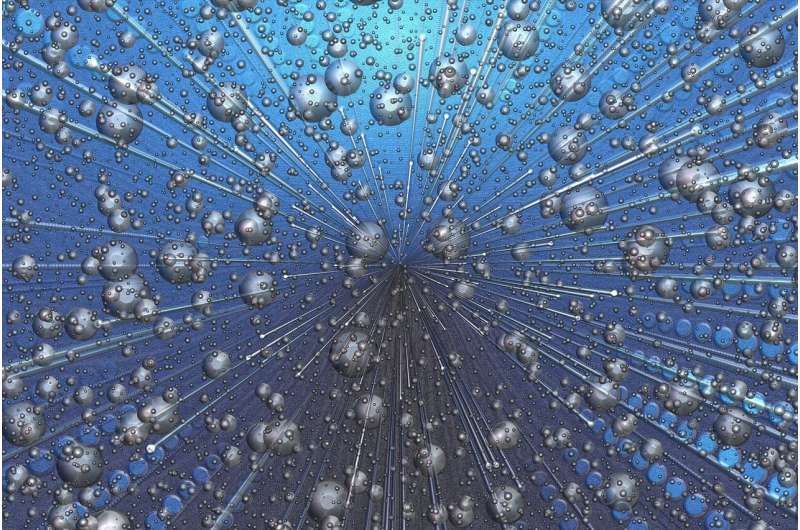This article has been reviewed according to Science X's editorial process and policies. Editors have highlighted the following attributes while ensuring the content's credibility:
fact-checked
peer-reviewed publication
trusted source
proofread
Research reveals rare metal could offer revolutionary switch for future quantum devices

Quantum scientists have discovered a rare phenomenon that could hold the key to creating a 'perfect switch' in quantum devices which flips between being an insulator and a superconductor.
The research, led by the University of Bristol and published in Science, found these two opposing electronic states exist within purple bronze, a unique one-dimensional metal composed of individual conducting chains of atoms.
Tiny changes in the material, for instance, prompted by a small stimulus like heat or light, may trigger an instant transition from an insulating state with zero conductivity to a superconductor with unlimited conductivity, and vice versa. This polarized versatility, known as "emergent symmetry," has the potential to offer an ideal On/Off switch in future quantum technology developments.
Lead author Nigel Hussey, Professor of Physics at the University of Bristol, said, "It's a really exciting discovery which could provide a perfect switch for quantum devices of tomorrow.
"The remarkable journey started 13 years ago in my lab when two Ph.D. students, Xiaofeng Xu and Nick Wakeham, measured the magnetoresistance—the change in resistance caused by a magnetic field—of purple bronze."
In the absence of a magnetic field, the resistance of purple bronze was highly dependent on the direction in which the electrical current was introduced. Its temperature dependence was also rather complicated. Around room temperature, the resistance is metallic, but as the temperature is lowered, this reverses and the material appears to be turning into an insulator. Then, at the lowest temperatures, the resistance plummets again as it transitions into a superconductor.
Despite this complexity, surprisingly, the magnetoresistance was found to be extremely simple. It was essentially the same irrespective of the direction in which the current or field was aligned and followed a perfect linear temperature dependence all the way from room temperature down to the superconducting transition temperature.
"Finding no coherent explanation for this puzzling behavior, the data lay dormant and published unpublished for the next seven years. A hiatus like this is unusual in quantum research, though the reason for it was not a lack of statistics," Prof Hussey explained.
"Such simplicity in the magnetic response invariably belies a complex origin and as it turns out, its possible resolution would only come about through a chance encounter."
In 2017, Prof Hussey was working at Radboud University and saw advertised a seminar by physicist Dr. Piotr Chudzinski on the subject of purple bronze. At the time few researchers were devoting an entire seminar to this little-known material, so his interest was piqued.
Prof Hussey said, "In the seminar Chudzinski proposed that the resistive upturn may be caused by interference between the conduction electrons and elusive, composite particles known as dark excitons. We chatted after the seminar and together proposed an experiment to test his theory. Our subsequent measurements essentially confirmed it."
Buoyed by this success, Prof Hussey resurrected Xu and Wakeham's magnetoresistance data and showed them to Dr. Chudzinski. The two central features of the data—the linearity with temperature and the independence of the orientation of current and field—intrigued Chudzinski, as did the fact that the material itself could exhibit both insulating and superconducting behavior depending on how the material was grown.
Dr. Chudzinski wondered whether rather than transforming completely into an insulator, the interaction between the charge carriers and the excitons he'd introduced earlier could cause the former to gravitate towards the boundary between the insulating and superconducting states as the temperature is lowered. At the boundary itself, the probability of the system being an insulator or a superconductor is essentially the same.
Prof Hussey said, "Such physical symmetry is an unusual state of affairs and to develop such symmetry in a metal as the temperature is lowered, hence the term 'emergent symmetry," would constitute a world-first."
Physicists are well versed in the phenomenon of symmetry breaking: lowering the symmetry of an electron system upon cooling. The complex arrangement of water molecules in an ice crystal is an example of such broken symmetry. But the converse is an extremely rare, if not unique, occurrence. Returning to the water/ice analogy, it is as though upon cooling the ice further, the complexity of the ice crystals 'melts' once again into something as symmetric and smooth as the water droplet.
Dr. Chudzinski, now a research fellow at Queen's University Belfast, said, "Imagine a magic trick where a dull, distorted figure transforms into a beautiful, perfectly symmetric sphere. This is, in a nutshell, the essence of emergent symmetry. The figure in question is our material, purple bronze, while our magician is nature itself."
To further test whether the theory held water, an additional 100 individual crystals, some insulating and others superconducting, were investigated by another Ph.D. student, Maarten Berben, working at Radboud University.
Prof Hussey added, "After Maarten's Herculean effort, the story was complete and the reason why different crystals exhibited such wildly different ground states became apparent. Looking ahead, it might be possible to exploit this 'edginess' to create switches in quantum circuits whereby tiny stimuli induce profound, orders-of-magnitude changes in the switch resistance."
More information: P. Chudzinski et al, Emergent symmetry in a low-dimensional superconductor on the edge of Mottness, Science (2023). DOI: 10.1126/science.abp8948
Journal information: Science
Provided by Queen's University Belfast





















